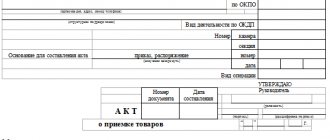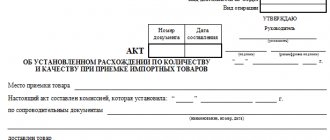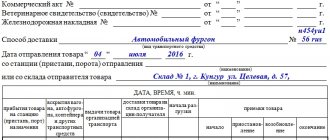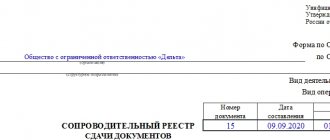What is a TORG-12 consignment note?
The TORG-12 consignment note is a document for processing operations for the transfer or receipt of inventory items, which is the primary accounting document.
TORG-12 is drawn up in two copies, of which the first copy remains with the organization handing over the inventory and is the basis for their write-off, and the second copy is transferred to a third party and is the basis for the receipt of goods (inventory).
Document preparation
Just like the content, the design of the form depends entirely on the vision of the document by representatives of organizations and their needs. The form can be drawn up on a simple blank A4 sheet or on the company’s letterhead, and it can be filled out either by hand or on a computer.
Important condition! The invoice must contain “live” signatures of materially responsible employees: the one who authorized the release of products, the one who directly carried it out, and the buyer.
At the same time, it is necessary to certify the invoice using stamped products only if the norm for their use is enshrined in the internal regulations of the company.
The document is always made in at least two identical copies , one of which is handed over to the representative of the receiving party, the second remains with the employee of the company distributing the products.
Federal Law “On Accounting” Art. 9 p. 2
The required details of the primary accounting document are:
- Title of the document;
- date of document preparation;
- name of the economic entity that compiled the document;
- content of the fact of economic life;
- the value of the natural and (or) monetary measurement of a fact of economic life, indicating the units of measurement;
- the name of the position of the person (persons) who completed the transaction, operation and the person(s) responsible for its execution, or the name of the position of the person(s) responsible for the execution of the event;
- signatures of persons provided for in Art. 2 clause 6 of the Federal Law “On Accounting”, indicating their last names and initials, or other details necessary to identify these persons.
Additional details of the primary accounting document The consignment note, in addition to the mandatory details, may contain any additional information; this is not a violation.
The upper part of the consignment note TORG-12 (header)
- TORG-12 is created in two copies, one for the seller and the other for the buyer.
- The invoice number must correspond to the document numbering approved in the organization’s accounting policies.
- The date of the invoice is indicated as current, at the time of the fact of economic life or after its end, in accordance with Art. 9 clause 3 of the Federal Law “On Accounting”.
- The Shipper column is filled in with the details of the shipper organization. In practice, this column usually coincides with the Supplier , or the details of another organization that is the shipper (for example, a transport company) are indicated.
- The Structural unit column is filled in if inventory items are transferred from a separate unit of the supplier organization.
- Consignee column is filled in with the details of the consignee organization. In practice, this column coincides with the Payer , or the details of another organization that is the consignee are indicated.
- The Supplier column is filled in with the details of the supplier organization, i.e. this column indicates the details of the organization selling the product.
- The Payer column is filled in with the details of the paying organization, i.e. it contains the details of the organization to which the goods are sold.
- The details of the Shipper , Consignee , Supplier and Payer must indicate: name of the organization or entrepreneur, address, telephone, fax, INN, KPP, bank details, name of the bank, BIC, correspondent account, r/account or l/account.
- Opposite all details at the end of the line, a special field is filled in - OKPO code .
- The type of activity according to OKDP is not filled in in practice; the field remains empty.
- In the Basis , “Account” or “Agreement” is usually indicated; at the end of this line, in special fields, the number
and
date
are indicated, respectively, the number and date of the Invoice or Agreement. - In the column number
and
date
of the Waybill, its number and date are indicated, respectively. This field is optional; it can be left blank if the waybill is not created. - Type of operation - in practice it is not filled in, the field remains empty.
Sample of drawing up an invoice
Since 2013, single, standard unified forms of primary accounting documents have been abolished, therefore there is no standard form of invoice. Company employees can draw it up in any form, using previously existing, mandatory document samples (form TORG 12, TORG 14, etc.), or, if the organization has its own developed and approved invoice template, based on it. The main thing is that in its structure it corresponds to certain standards of office work, and in content it includes a number of certain information.
Conventionally, the invoice can be divided into three parts: the “header”, the main part and the conclusion. The first is entered in order:
- number and date of document preparation;
- the name of the organization that issues the goods and the name of the organization that receives it (if it is an individual or individual entrepreneur, respectively, his last name, first name and patronymic name are entered here);
- a reference is also made here to the agreement for the purpose of which this operation is being carried out (its number and date of conclusion are indicated);
- if one of the persons involved in the transfer of inventory items acts on the basis of a power of attorney, information about this must also be included in the invoice, indicating its number and date of issue.
The second , main part of the document, which is usually formed in the form of a table, contains detailed information about the inventory items sold:
- their name;
- quantity (in appropriate units of measurement - pieces, liters, kilograms, meters, etc.);
- price for one;
- total cost.
If necessary, this section of the document can be supplemented with other information, including the variety, category, type, purpose, features, packaging, storage conditions of products, etc. The length of the table depends on how many products are entered into it.
The final part of the form includes the following information: the number of items of goods and the total amount (both of these values are taken from the table).
List of goods in the delivery note TORG-12
The table with the list of goods is filled with data in accordance with the column headings.
- Column 1 - item number , indicates the serial number of the product.
- Column 2 - Name , indicates the name, characteristics, grade, and article number of the product. If you have a trade turnover and each product is assigned an article number, then it is in this field that it is indicated, either before or after the name of the product, separated by a comma, in parentheses, separated by a dash or other sign.
- Column 3 - Code , in practice it is not filled in and is marked with a dash. This field is in addition to the name of the product and is indicated if it is impossible to identify the product by the name of the product (by the second column).
- Column 4 and 5 - Unit of measurement , indicate the name and code of the unit of measurement of the product, in accordance with the OKEI classifier.
- Column 6 - Type of packaging , in practice is not filled in and is marked with a dash.
- Column 7 and 8 - Quantity , in one place and places, pieces , in practice, is usually not filled in and is marked with a dash. Please note that the quantity of the product is indicated in the tenth column.
- Column 9 - Gross weight , in practice it is usually not filled in and is marked with a dash.
- Column 10 - Quantity (net weight) , indicates the quantity of the product.
- Column 11 - Price, rub. cop. , the price per unit of goods is indicated without VAT.
- Column 12 - Amount excluding VAT, rub. cop. , indicates the amount of the product excluding VAT.
- Column 13 and 14 - VAT rate, % and amount, rub. cop. , the VAT percentage rate and the VAT amount are indicated.
- Column 15 - Amount including VAT , indicates the amount of the product including VAT.
Total by invoice - the sums of numbers in columns Nos. 8, 9, 10, 12, 14 and 15 are summed up.
The lower part of the consignment note TORG-12 (basement)
The lower part contains the summary data of the delivery note:
- The consignment note has an attachment on _ sheets - in practice it is not filled out, it is marked with a dash.
- contains _ serial numbers of records - indicates the number of serial numbers of the record in the list of goods. You must write the number in words.
- Total seats _ - in practice it is not filled in, it is marked with a dash.
- Cargo weight (net) _ and Cargo weight (gross) _ - in practice they are not filled in, they remain empty.
- Application (passports, certificates, etc.) on _ sheets - in practice it is not filled out, a dash is added.
- Total issued for the amount of _ - indicates the total amount of all goods in the invoice. You must write the amount in words.
Signatures of responsible persons (left side, seller):
- The release of cargo is authorized - the position, full name and signature of the responsible person are indicated.
- Chief (senior) accountant - the full name and signature of the chief accountant are indicated.
- The cargo has been released - the position, full name and signature of the responsible person are indicated.
Shipment of goods . An individual entrepreneur signs only once in the column Release of cargo allowed. In large companies, different people can sign in all three places, in accordance with their job responsibilities. In small companies, the same person may sign in all three places, for example, the General Director . The manager can also sign in all three fields, but only with a valid intra-organizational order with the right to ship goods, sign shipping and accounting documents.
Return processing features
When inconsistencies are discovered at the time of acceptance (insufficient number of items, discrepancies with the basics of the concluded agreement, etc.), a report is drawn up immediately on the spot. It reflects the nuance of shortcomings in the qualitative and quantitative values of the delivered product. Formation is carried out according to the TORG-2 form.
If deviations from the specified parameters are identified after capitalization of inventory items, sending them for storage or registration, the selling and purchasing parties should draw up return documentation.
Receipt of goods by proxy and rules for filling out TORG-12
The goods can be received by an authorized person by providing a power of attorney form M-2, M-2a, executed in the prescribed manner, with the obligatory presentation of an identification document (passport). The power of attorney remains with the Seller.
Filling out TORG-12 by proxy . If the goods are received by proxy, the following three fields must be filled in:
- By power of attorney No. _ - indicates the number and date of issue of the power of attorney. If the power of attorney is without a number, then the identification number and the date of its issue are indicated.
- issued _ - the name of the organization that issued the power of attorney is indicated (for example, Buyer LLC, forwarder A.V. Ivanov).
- Next, in the Cargo Accepted , the position, signature and full name of the person to whom the power of attorney was issued is entered. If the power of attorney is issued to a person who is not an employee of the organization, then the position is not indicated.
The power of attorney of form M-2, M-2a gives a specific right, namely, the receipt of inventory items; accordingly, the right to sign only in the Cargo accepted . the right to sign in the Cargo .
How to sign a delivery note: sample filling
A document drawn up in accordance with all the rules must be endorsed by all participants in the process. These are representatives of the selling and buying parties who are authorized to perform these actions.
In some cases, the goods are picked up by a trusted person cooperating with the buyer. In this situation, information about him and the details of the written authorization are entered in the appropriate column. In the sub-item “Received the cargo”, the employee of the organization who is responsible for the location of the products in the warehouse area leaves his signature.
For the electronic version of the twelfth waybill, the electronic signatures of both the shipper and the recipient will be required. Keep in mind that the digital document is compiled in one copy, but contains 2 files.
If regular paper documentation is used when concluding a transaction, the following personal notes are made:
- signature of a representative of the purchasing party confirming acceptance of the cargo;
- the person financially responsible for the acceptance of the goods by the customer;
- the boss, the accountant and the employee responsible for the shipment from the shipper.
With regard to seals, there is complete freedom of action. They are affixed only when used in companies. Not mandatory. However, it should be taken into account that there is a special place for them in the form. This means that it is better not to neglect the opportunity to leave an impression. This way you will be able to avoid possible problems with inspection authorities.
Receiving goods without a power of attorney (carrying a stamp)
- Only its sole executive body, for example, the general director, can receive goods on behalf of an organization without a power of attorney. However, in this case, the seller, before drawing up the delivery note, is obliged to make sure that the person receiving the goods is the real sole executive body. It is necessary to request a document on the appointment of the general director, which contains passport data, and also require the presentation of the passport itself to verify this data.
- The goods can also be received by a materially responsible person appointed by order of the General Director, or on the basis of a general power of attorney. The order and the general power of attorney must clearly indicate the authority to receive the goods and the right to sign the TORG-12 consignment note, as well as the passport details of the materially responsible person. The seller is also obliged to verify passport data when shipping the goods.
In both cases, the signature is placed in only one column. The cargo was received by the consignee :
- The cargo was received by the consignee - filled in when the consignee receives the goods. The position, full name and signature are indicated (for example, General Director Petrov V.A.).
Date in the consignment note TORG-12
- Date of compilation - indicates the actual date of compilation of the invoice.
- Product shipment date —indicates the actual date of shipment of the product from the warehouse.
- Date of receipt of goods - indicates the actual date of receipt of the goods.
Most accountants tend to have three identical dates on the invoice: the date of the invoice, the date of shipment and the date of receipt of the goods. Thus, in the future, the accountant will be able to easily post such a document in accounting (in an accounting program).
It is strongly recommended that you seek clarification from your accountant on completing the date. In practice, a situation can quite easily arise when all three dates are different. And this situation will complicate the work of the accountant, who has a headache about how to properly capitalize the goods, to which temporary or virtual warehouse to move the goods, when to write them off, etc.
What is it for?
When looking at examples of completed TORG-12 invoices with mandatory fields to fill out, you should remember that this document is actively used by two parties: the selling and the buying. With its help, the seller controls the shipment of goods from the warehouse, and the buyer issues acceptance. According to this type of technical specification, the supplier writes off product items. The document is usually drawn up by an accountant, storekeeper or other person authorized to carry out such transactions. The consignee, in turn, records the receipt of the cargo according to this form.
Representatives of regulatory authorities are often interested not only in the paper itself, but also in the additions that come with it: product certificates, passports, and various certificates.





